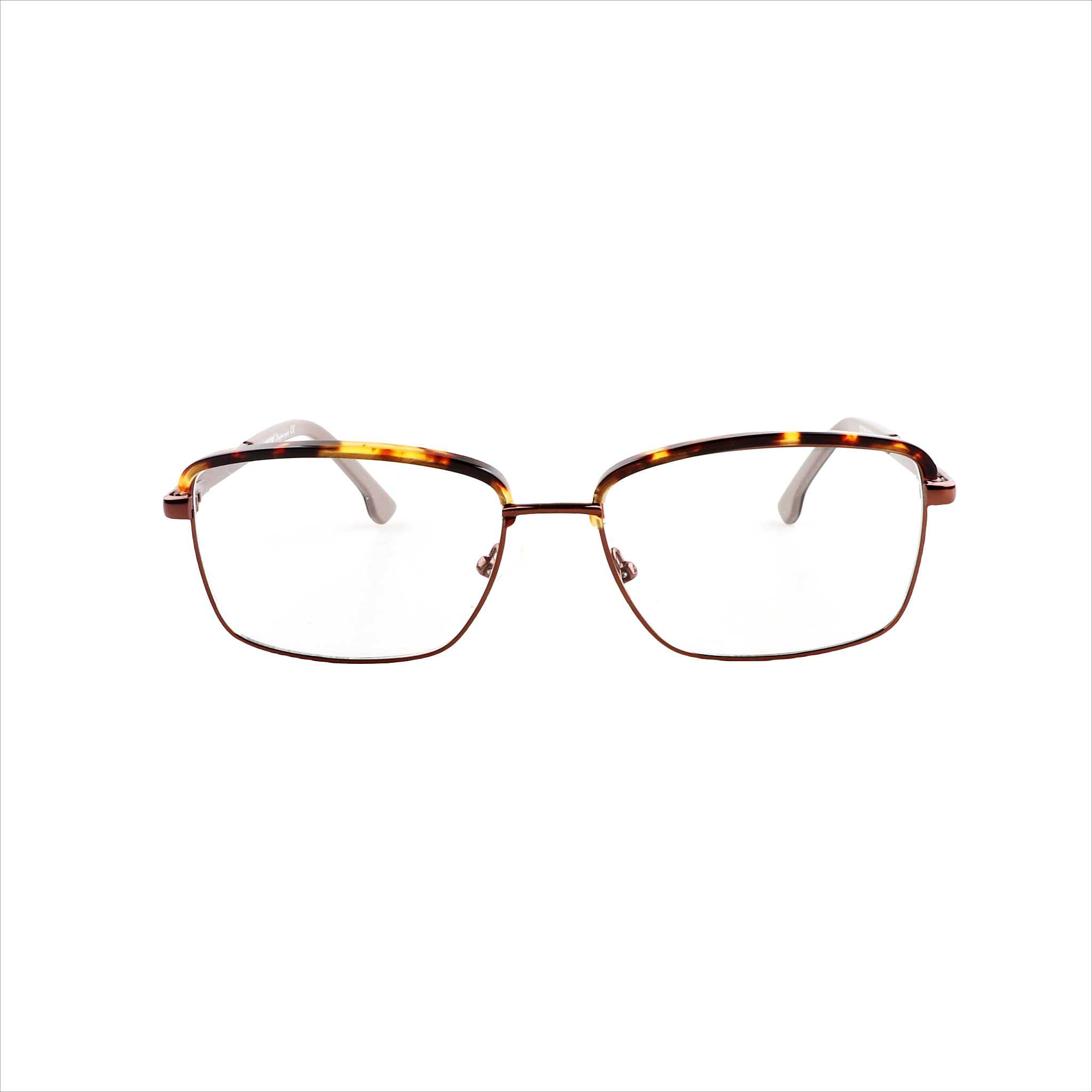Materials and Frame Construction

At LENZO Designer Eyes, our eyewear collections are crafted with high-quality materials that ensure durability, comfort, and style. Understanding the materials and frame construction behind each type can help you make an informed choice, especially if you're looking for longevity and premium comfort. Here’s a closer look at the materials we use, particularly for our Premium and Luxury Series:
1. Titanium
- Description: Known for its lightweight feel, strength, and hypoallergenic properties, titanium is a top choice for premium eyewear.
- Benefits: Titanium frames are extremely durable and corrosion-resistant, making them ideal for long-lasting wear. Their lightness makes them exceptionally comfortable, especially for all-day use.
- Who It’s For: Perfect for individuals with sensitive skin or those looking for a lightweight yet durable frame. Featured prominently in our Luxury Series.
2. Acetate
- Description: Acetate is a plant-based, high-quality plastic material known for its versatility in color and design, allowing for unique textures and color patterns.
- Benefits: Stronger and more flexible than regular plastic, acetate frames are hypoallergenic and lightweight. The material is also highly customizable, allowing for a range of colors and styles that stay vibrant over time.
- Who It’s For: Ideal for those looking for eyewear that combines comfort with bold style. Frequently used in our Premium Series due to its balance of durability and aesthetic appeal.
3. TR-90
- Description: TR-90 is a thermoplastic material known for its durability, flexibility, and lightweight nature.
- Benefits: Highly resistant to wear and tear, TR-90 frames are flexible, which makes them resistant to breaking or deforming under stress. They also provide a comfortable fit, adapting well to different face shapes.
- Who It’s For: Suitable for active lifestyles and individuals looking for comfortable, everyday frames in our Basic Series.
4. Stainless Steel
- Description: Stainless steel frames are robust and offer a sleek, minimalist aesthetic.
- Benefits: Corrosion-resistant and durable, stainless steel frames are sturdy while remaining lightweight, making them a great choice for modern styles. They often feature flexible hinges for added comfort.
- Who It’s For: Ideal for customers seeking a durable, minimalist look in their eyewear. You’ll find these in select Premium Series frames.
5. Aluminum
- Description: Aluminum frames are lightweight and sleek, often used for their stylish, industrial look.
- Benefits: Though lightweight, aluminum frames are strong and resistant to corrosion. Often anodized for a smoother finish, they are a popular choice in premium eyewear for their unique aesthetic.
- Who It’s For: Great for those who value modern design and lightweight comfort. Aluminum frames are used selectively in our Luxury Series.
Frame Construction Quality
Our frames are engineered with precise craftsmanship to ensure durability, flexibility, and a comfortable fit:
- Rimless and Semi-Rimless Frames: Engineered to be lightweight, using high-tensile materials like titanium for longevity and added comfort.
- Hinges: Premium and Luxury Series frames are equipped with high-quality spring hinges for enhanced flexibility and resilience.
- Nose Pads and Tips: Designed for comfort, many of our frames feature adjustable, hypoallergenic nose pads and coated temple tips for a secure, slip-free fit.
Why Material Matters for Premium and Luxury Eyewear
Frames crafted from premium materials, like titanium and acetate, provide superior comfort, durability, and style. The careful construction process ensures that each frame is crafted to last, making them an ideal choice for customers seeking both quality and long-term value in their eyewear.
By understanding the unique benefits of each material, you can choose a frame that best meets your needs, whether it's for style, comfort, or all-day wear.
Guide to Frame Materials for Eyewear
Choosing the right frame material can make a significant difference in the performance, comfort, and longevity of your eyewear. Here’s a deep dive into popular frame materials, categorized by their type, manufacturing process, durability, and performance insights.
Plastic-looking Materials
|
Material |
Regular Plastic |
ULTEM |
Acetate (Cellulose Acetate) |
TR90 (Thermoplastic Elastomer) |
|
Process |
Injection molded, mass-manufactured |
Injection molded, high-temperature resistant |
Handcrafted and polished for precision |
Injection molded with high tensile strength |
|
Flexibility & Strength |
Brittle under extreme temperatures |
Exceptionally flexible with memory resilience |
Firm structure with moderate flexibility |
High tensile strength with shape memory capabilities |
|
Weight |
Lightweight but less dense |
Ultra-light, optimized for long wear |
Medium density, balanced for durability and comfort |
Ultra-light, maintains balance even with larger frames |
|
Longevity |
Prone to gradual expansion with heat |
High thermal stability, resists warping |
Maintains shape and luster even in varied climates |
UV and temperature resistant, retains original shape |
|
Corrosion & Scratch Resistance |
Moderate corrosion resistance, prone to surface damage |
High resistance to corrosion, minimal scratching |
Excellent corrosion resistance, retains polish |
High scratch and corrosion resistance due to inherent material properties |
|
Performance Fit |
Limited application due to brittleness |
Ideal for sport/performance eyewear |
Perfect for high-end fashion frames with custom finishes |
Great for active lifestyles, recommended for everyday performance eyewear |
Insights:
- Regular Plastic: Economical but less resilient; ideal for occasional eyewear.
- ULTEM: Combines lightness and flexibility, ideal for high-stress environments or sports.
- Acetate: Preferred for premium fashion eyewear, with a custom look that holds up well over time.
- TR90: High resistance to physical strain, making it suitable for active lifestyles and all-day comfort.
Metal-looking Materials
|
Material |
Alloy |
Beryllium |
Titanium |
Aluminum |
Stainless Steel |
|
Process |
Alloy blend, often injection molded |
High-grade machine-molded for lightweight frames |
Advanced processing techniques for corrosion resistance |
Forged, heat-treated for added durability |
Machine-fabricated with precise structural integrity |
|
Flexibility & Strength |
Moderate flex, prone to warping |
Strong, non-reactive, with moderate flexibility |
Maximum strength-to-weight ratio, highly flexible |
Strong but can be softer than titanium or steel |
High strength, resists bending while offering moderate flexibility |
|
Weight |
Moderate; denser than titanium |
Light, making it comfortable for prolonged wear |
Ultra-light, ideal for large frame designs |
Light, comparable to beryllium |
Medium; more durable but slightly heavier than aluminum |
|
Longevity |
May gradually expand with temperature shifts |
Maintains shape, excellent for frequent wear |
Holds up indefinitely with a stable finish |
Stable, may slightly expand in extreme conditions |
Consistent, durable finish, holds shape over long periods |
|
Corrosion & Scratch Resistance |
Moderate corrosion resistance |
Medium resistance to corrosion |
Outstanding resistance to corrosion |
Excellent resistance; may scratch easily on surface |
Excellent corrosion resistance with high scratch durability |
|
Performance Fit |
Economical, ideal for daily wear |
Excellent for active lifestyles and sports |
Perfect for high-performance frames, comfortable |
Good for trendy or everyday wear |
Durable for daily wear, ideal for those seeking resilience |
Insights:
- Alloy: Affordable and durable but not suited for extreme flexibility.
- Beryllium: Highly resistant to corrosion, ideal for active or coastal environments.
- Titanium: Industry gold standard for luxury and durability; exceptionally light and hypoallergenic.
- Aluminum: Great for stylish, lightweight frames but can be prone to scratches.
- Stainless Steel: Durable and resilient, often used for robust daily wear frames.
Other Innovative Materials
|
Material |
Wood |
Rubber |
Carbon Fiber |
Nylon |
|
Process |
Handcrafted, artisanal, often unique grains |
Machine-molded for precision fit |
Hand-layered for optimal strength-to-weight ratio |
Injection molded, optimized for strength and flexibility |
|
Flexibility & Strength |
Naturally stiff, unique textures |
High flexibility, impact-resistant |
Exceptional strength-to-weight ratio, flexible yet rigid |
High flexibility, UV-resistant |
|
Weight |
Moderate, depends on type of wood |
Light and balanced |
Light yet sturdy, ideal for dynamic frames |
Light, easily adaptable to large frames |
|
Longevity |
Expands slightly with temperature, requires care |
Expands slightly under extreme heat |
Incredibly durable with high resistance to wear and tear |
Retains shape over time, may expand slightly |
|
Corrosion & Scratch Resistance |
Moderate, varies with wood finish |
Moderate to high resistance |
Outstanding scratch and corrosion resistance |
Medium scratch resistance |
|
Performance Fit |
Statement pieces, suited for luxury and fashion |
Perfect for sports and high-impact activities |
Top choice for advanced performance eyewear |
Ideal for flexible sports frames or high-performance designs |
Insights:
- Wood: Natural and unique, great for eco-conscious consumers.
- Rubber: Extremely resilient, suited for sports and rugged environments.
- Carbon Fiber: Ultimate choice for performance, offering unparalleled strength-to-weight ratio.
- Nylon: Flexible, lightweight, and resilient under high-stress conditions.
Key Takeaways for Frame Material Selection
- Durability Needs: For robust, everyday wear, Titanium and Stainless Steel offer the highest durability and are resistant to most environmental factors.
- Style and Comfort: Acetate frames are the choice for fashion and comfort, combining durability with a stylish finish.
- Active Lifestyles: ULTEM, TR90, and Rubber frames offer flexibility and resilience for high-impact activities or long-term wear.
- Premium Performance: Carbon Fiber and Titanium frames provide the best in performance, combining lightness with unmatched strength.
By aligning frame materials with lifestyle, environment, and style preferences, you can achieve optimal comfort and longevity for any eyewear choice.








